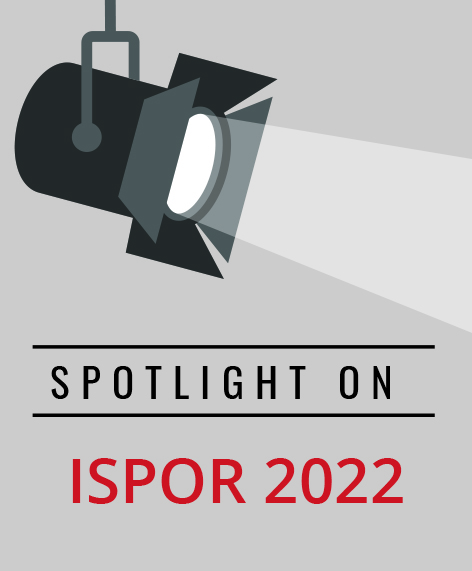Using Big Data to Unpack the Health Equity Considerations
Tyler D. Wagner, PharmD, Virginia Commonwealth University School of Pharmacy, Richmond, VA, USA; Jacinda Tran, PharmD, MBA, Comparative Health Outcomes, Policy, and Economics (CHOICE) Institute, University of Washington, Seattle, WA, USA
ISPOR Annual 2022 Welcome and Brief Reports
The second day of the ISPOR conference began with Nancy Berg, ISPOR’s CEO and Executive Director, thanking the conference supporters and sponsors. Berg introduced ISPOR’s President-Elect, Jan Hansen, PhD, who will begin her term on July 1, 2022.
In Hansen’s address, she discussed engaging healthcare stakeholders to proactively inform healthcare decisions through the use of HEOR data and approaches that are scientifically rigorous and sound. She highlighted many of ISPOR’s tools and resources, including the Top 10 HEOR Trends Report, the HEOR Competencies Framework, ISPOR Short Courses, and Special Interest Groups, to help educate stakeholders and collaborate to advance the application of HEOR methods in healthcare decision making.
Hansen called upon current ISPOR members to develop themselves as leaders in the profession, to be passionate and curious about the impact their work can have, and to advocate and evangelize for their work. In return, she made a commitment to frequently and consistently communicate with members about the impact of the HEOR discipline and the impact of ISPOR has on people and health systems around the world.
Hansen introduced Richard Willke, PhD, ISPOR’s Chief Science Officer, who highlighted key area the Society is currently focusing on: developing strong methods, engaging the payer community, increasing transparency and credibility of real-world evidence, and leveraging the data and tools in digital health. Willke encouraged ISPOR members to share their thoughts with him about new topics and ongoing areas of work that could help inform what the ISPOR Science Office focuses on.
Willke then introduced Ran Balicer, MD, PhD, MPH, an ISPOR 2022 Program Committee Co-Chair, who pointed out that the majority of Tuesday’s sessions focus on health equity, healthcare systems, and patient data. Balicer introduced Ebere Onukwugha, PhD, ISPOR 2022 Program Committee Co-Chair, who moderated this plenary session on big data analytics, personalized medicine, and health equity considerations. To start the discussion, Onukwugha shared the World Health Organization’s definition of equity as the “absence of unfair, avoidable, or remediable differences between groups defined socially, economically, or geographically.”
"Should we include measures of race and ethnicity in risk prediction models developed using big data?"
Onukwugha set the stage for this challenging question, stating that, “When analyzing healthcare data, we can all agree that there are plenty of analytic tools and methods available, but what is less clear is how those methods fair when the goal is to inform decision making in diverse populations.
Michael Pencina, PhD, (Duke University School of Medicine, USA) led the discussion by introducing risk prediction models for stroke. The risk of stroke is substantially higher, by 30 to 50%, for black women compared to white women. However, these models perform much better in white individuals than nonwhite, and large racial biases have been identified in risk prediction models. Thus, “the risk and our ability to explain the risk go in opposite directions.” He then emphasized the importance of transparency and use of the simplest model to accomplish your goal.
Bob Darin, MBA, (Blue Health Intelligence, USA) who is currently serving as the interim CEO of a national healthcare analytics firm that works within the Blue Cross Blue Shield system to advance value-based care and health equity. Darin emphasized the organization’s commitment to bringing consideration of health equity in every aspect.
Next, Charles Manski, PhD, (Northwestern University, USA) discussed the use of race as a covariate in risk prediction models and patient-centered appraisal of race-free clinical risk assessment. He emphasized the importance of predictive power, and that knowing more about patients enables more accurate predictions about health risks and should enable better clinical decisions. However, there are increasing arguments that using race to predict health risk contributes to health inequality. For example, several institutions have recommended removing race as a predictor variable for eGFR. There is a concern that removing race from risk assessments will harm patients of all races because it would reduce the accuracy of predictions for everybody.
George Menash, MD, (National Institute of Health, USA) trained as a cardiovascular specialist and clinician-scientist. Because cardiovascular diseases has the most glaring disparities, Menash stated that his passion is “committed to the appropriate use of race/ethnicity and sex/gender to use them to guide and eliminate race and gender inequities in the world.”

From left to right: Bob Darin, Michael Pencina, and Ebere Onukwugha, speaking at the ISPOR Annual 2022 plenary session
When the goal is to do the best job possible, what are the pros and cons with incorporating race/ethnicity in risk prediction models?
Pencina led off the discussion by emphasizing the importance of thinking about the application and the implication. He highlighted that we’re using race as a proxy, but we don’t know if race is an appropriate proxy because we haven’t collected the data for variables that race approximates. He further elaborated on a key dilemma: Is it better to use an imperfect proxy or to not include it in the models at all? Pencnia stressed that the problems with keeping race in is that it describes a social construct and 2 people of the same race may or may not share much in common. Everyone should think about the implications and make a decision with that in mind.
Darin followed by stressing the importance of the face validity of algorithms and the need to be transparent. Manski agreed, stating “of course race is a proxy, as there are many ways that it is classified, and there is no agreement on any of it. Everything used in medical risk assessment is a proxy, systolic blood pressure and diastolic blood pressure is a screening test and is a proxy for hypertension. The big point is that we always want to get better and better measures, to get underneath and get better measures that have increased predictive power.”
Menash agreed with Manski, emphasizing that when we talk about blood pressure, there is a notion that it is a biological variable and is precise, but one would be amazed at how poorly BP is measured in the doctor’s office, with poor precision. “If our goal is to do the best job possible, then we should include race and ethnicity variables in the risk prediction models. These are socioeconomic variables and cultural variables, and as such, are fairly imprecise, often confounded. Yet despite these limitations, excluding them will lead to challenges and biases in the short term, and will lead to significant challenges in developing more precise models in the future.”
"Many healthcare systems have pulled race and or ethnicity out of their databases so not to infuse bias into their analyses. What are some successful examples in developing data that is fit for purpose?"
Darin started the discussion, stating that having the data is critical and taking data out of the database takes away information and insight that you can act on. Just because we don’t publish the data, doesn’t mean the problem isn’t there. Pencina agreed, stating that “To stop measuring doesn’t mean the problem will go away.” He further emphasized that we need to strive to add new variables and measure them better. Pencina can imagine a world where we do not need to add race to prediction models because other included variables are more informative. Unfortunately, we are not there yet—on the health system level or the cohort study level.
Manski emphasized that the question goes well beyond race—it goes to the quality of risk-prediction algorithms. “The data and the modeling should both be improving over time, but the problem is that things can get stuck. Once something gets done and is accepted, it’s hard to move beyond it.” Manski used breast cancer screening as an example, which is based on the Gail Model. Once there’s an innovation, how do you keep the process of innovation going without something becoming the standard of care and not being able to move beyond it? Race and ethnicity are part of this, but there’s a bigger issue.
Menash felt that we should always include health equity and sex and gender variables from the beginning—essentially, using a health equity lens from the outset. When asked to describe what this might look like, he identified 5 important characteristics that must be considered and included: (1) community engagement, (2) inclusive participation, (3) including social determinants of health into models, (4) ensuring that we are asking and using the right variables and the right proxy, and (5) addressing ethical, privacy, and trust issues.

From left to right: Charles Manski, PhD and George Menash, MD, contribute to the discussion on data analytics and health equity
The debate about race and ethnicity, their use as predictors, and their subsequent implications continues to evolve. As the panelists emphasized in their closing remarks, there is still much work to be done. It is important to remain transparent, formulate the correct questions, consider the implications, collaborate to answer these questions, and continue these conversations about health equity.

